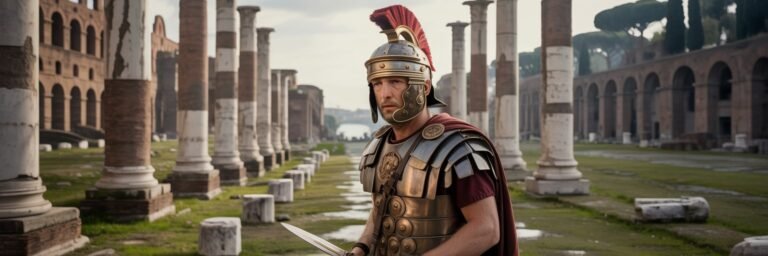INTRODUCTION
The course of human history is marked by complex and ever-shifting societies, each leaving indelible impressions on the ensuing eras. As time’s relentless tide seizes the remains of these societies, the task falls upon the historians and archaeologists alike to unravel and examine the mystifying codes of these past superstructures. Amid the vast tapestry of historical studies, the Roman Empire continues to capture the fascination and curiosity of the modern intellect. The dynamism, complexity, and enduring legacy of this colossus of antiquity makes it compelling to draw comparisons to modern society. This article invites readers on a journey through time, exploring the many faceted comparisons between the classical Roman Empire and the modern world.
HISTORICAL BACKGROUND
Like a cultural volcano erupting from the fertile soil of civilization, the Roman Empire grew from a collection of Latin-speaking tribes along the Tiber River in the 8th century B.C to reign supreme in the Mediterranean until 476 A.D. During its peak, the empire reached as far as the British Isles to the north, the deserts of Arabia to the east, and the Sahara to the south. Much like the web of interconnected nations today, Rome was a cosmopolitan epicenter, orchestrating extensive networks of trade, politics, and society.
Much like its present counterparts, Roman society was an amalgamation of various elements: Politics, economics, law, religion, and culture thrived and evolved, creating a megalithic entity with Rome at its epicenter. From the powerful autocracy of the emperors, like Augustus, to the legal institutions that enforced order and justice, to the ambitious architectural and engineering feats such as the Colosseum and the aqueducts, Rome was a mirror to the modern world in its complexity and diversified values.
THEORIES AND INTERPRETATIONS
A prevailing theory, as proposed by historian Edward Gibbon in his book “The History of the Decline and Fall of the Roman Empire”, remarks upon the reflection of the Roman Empire’s decline within the recesses of modern society. Gibbon warned that the corroding factors that led to Rome’s fall, such as moral degradation, military overspending, societal divisions, and political corruption, ominously echo within our modern societies.
However, an alternate interpretation posits that Rome, unlike modern superpowers, was a slave-based economy, relegating it to a fate inherently different from our globalized, industrial society. This divergence asserts that lessons from Rome’s demise don’t apply to modern societies.
MYSTERIES AND CONTROVERSIES
The labyrinth of Roman history holds many unsolved riddles that continue to captivate modern researchers. For instance, the true cause of the fall of Rome remains contentious. From internal factors like political instability, economic troubles, and social decay, to external threats like barbarian invasions, historians remain in impassioned debate. The shadow of this controversy looms large over modern civilization. Can we decipher the past correctly to avoid the pitfalls foretold by the fall of Rome, or are we as blind as the ancients to the rot creeping within our walls?
SYMBOLISM AND CULTURAL SIGNIFICANCE
The Roman Empire embodies cultural significance and symbolism, rendering their discovery in our present society even more intriguing. Rome’s architectural feats inspire present-day marvels. Our legal systems, imbued with Roman principles of justice and governance, attest to our indebtedness to their advanced legal structures.
Similarly, the ubiquitous Latin language, famed for its brevity and precision, left its mark on our academic, scientific, and legal lexicons. Furthermore, Roman influences permeate in our calendar system and numeral notation, demonstrating the far-reaching effects of this ancient civilization.
MODERN INVESTIGATIONS
Modern researchers are employing innovative technology to probe deeper into the enigmatic remnants of Roman society. From advanced archaeology to landscape genomics, technology is aiding in deciphering the cultural, economic, and environmental contours of the Roman Empire. The rise in computer modeling has allowed historians to better understand ancient Roman demographics and economic structure—offering us deeper insights into how the empire functioned at its peak.
LEGACY AND CONCLUSION
As explored throughout this journey together, the ominous specter of Rome continues to cast its long shadow upon modern society. The Roman Empire exists not just as a chapter closed in the annals of time, but rather as a tutor and cautionary tale, reflecting our societies’ glories and failures. The legacy of Rome – its grandeur, innovation, downfall, and renewal – serves as a poignant reminder of how civilizations rise and fall.
The echo of Rome, a civilization perceived as invincible yet succumbed to the harsh judgment of time, urges us to learn and discern its lessons. As we ponder the future of our own societies amidst shared challenges of climate change, rise in inequality, and simmering socio-political strife, the historical tapestry of the Roman Empire behooves us to remember the cyclical nature of history.
However, similar to the complex nuances that defined Roman civilization, our modern society, rich in its diversity and resilience, isn’t destined to replicate Rome’s trajectory. Yet, an exploration of this ancient empire’s parallels guides our collective intellectual effort, as we chart our path forward, sustaining our civilization, and working towards a more progressive and inclusive society. The Roman Empire, in its enduring glance from the past, reminds us of the one steady truth: Change is constant.






